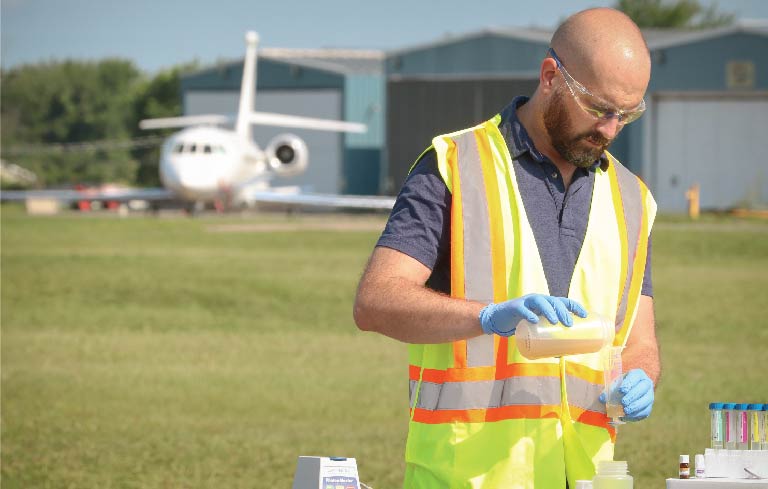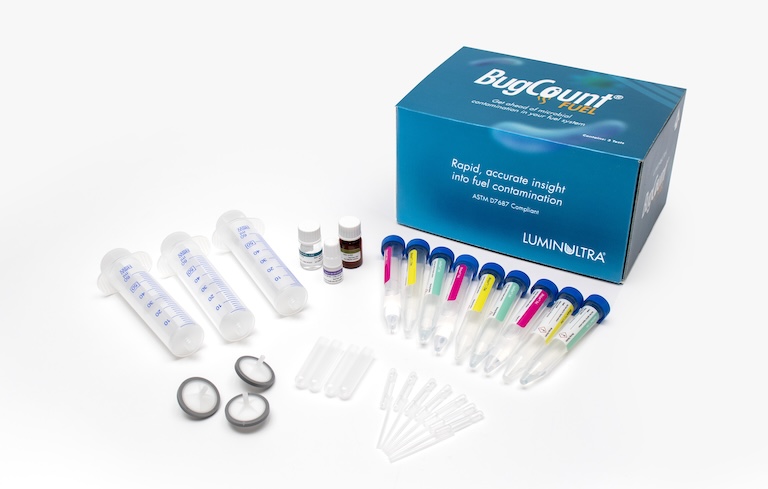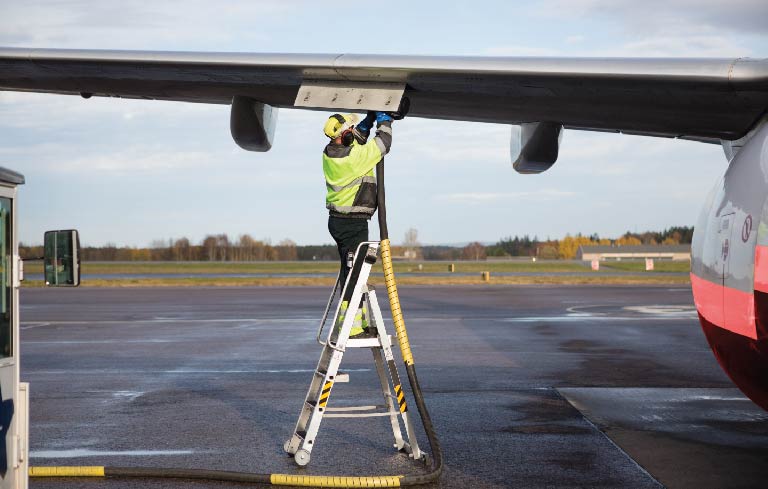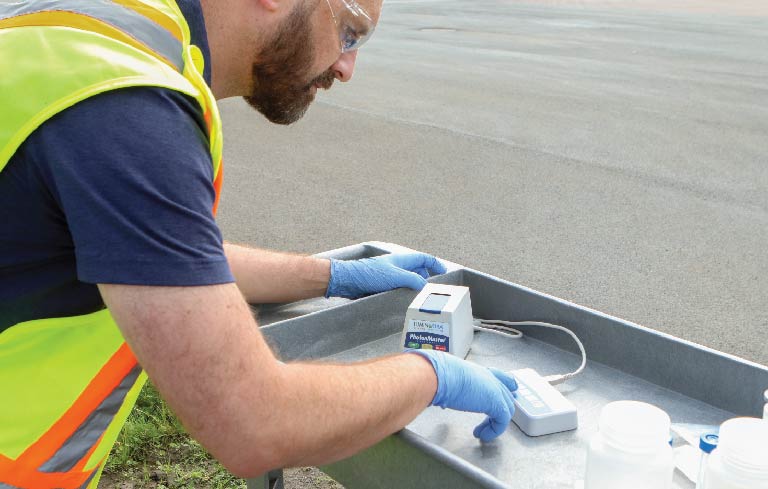Discover BugCount® Fuel
BugCount® Fuel revolutionizes fuel system testing
The responsibility of maintaining aircraft operations is critical. Microbial contamination in fuel systems poses an unseen threat, capable of impairing engine performance and potentially impacting flight safety. Every decision regarding fuel quality management has significant consequences.
The current challenge: A no-win choice
Existing testing methods present significant tradeoffs. Traditional cultures methods offer a high degree of familiarity but come with trade-offs — the time required for results could leave aircraft grounded for days, causing significant operational delays. Rapid test kits, while known and appreciated for their speed, often lack the accuracy required for dependable results. This forces aviation professionals into a difficult position – prioritize speed and risk potential inaccuracies, or prioritize accuracy and risk operational inefficiencies.
The burden of uncertainty
This constant tension between speed and accuracy presents poor outcomes. False positives can trigger unnecessary maintenance procedures, draining resources and extending downtimes. False negatives, even more problematic, leave aircraft vulnerable to undetected contamination – a result with potentially catastrophic consequences. This uncertainty is a significant challenge for aviation professionals.
The highest priority: safety above all else
Economic considerations – the high costs of delays and the pressure to maintain industry compliance – are important. However, there is an unwavering priority that transcends all others: the safety and reliability of every aircraft. The industry requires testing solutions that empower quick identification and elimination of any trace of microbial contamination in fuel systems.
Introducing LuminUltra’s BugCount® Fuel: A new era in fuel system testing
LuminUltra’s BugCount® Fuel is a game-changing solution, designed to address the speed and accuracy challenges faced today in aviation fuel management. This revolutionary product breaks the existing limitations, delivering speed and accuracy in fuel system contamination detection. That’s worth repeating: speed and accuracy in one test methodology.
Here’s what BugCount® Fuel offers:
- High accuracy: BugCount® Fuel delivers results professionals can trust, practically eliminating the false positives and negatives.
- Rapid turnaround time: Obtain reliable results in minutes, not days or hours, minimizing disruptions or delays to operations.
- Empowering precision: BugCount® Fuel equips professionals with the information needed to make swift and confident decisions regarding fuel system health and aircraft maintenance.
- Simplicity: BugCount® Fuel simplifies fuel testing with an industry-specific, user-friendly kit designed for on-the-spot, under-wing use—requiring no lab, special skills, or equipment.
BugCount® Fuel meets industry standards
Understanding the importance of industry confidence, BugCount® Fuel is proudly compliant with ASTM D7687, a globally recognized standard for aviation fuel contamination testing.
Furthermore, the ATP photometry methodology employed by BugCount® Fuel is a listed method for testing fuel and fuel-associated waters in the latest 6th Edition of the IATA Guidance Material on Microbial Contamination in Aircraft Fuel Tanks Appendix A. This alignment with established standards underscores the reliability and legitimacy of BugCount® Fuel’s rapid detection capabilities.
Benefits of BugCount® Fuel:
The advantages of BugCount® Fuel extend far beyond its industry-leading speed. Here’s a deeper exploration of the benefits BugCount® Fuel offers to various stakeholders in aviation fuel management:
Reduced downtime and cost savings
Traditional testing methods can keep aircraft grounded for days, leading to significant operational delays and lost revenue. BugCount® Fuel’s rapid turnaround time minimizes these disruptions, translating to substantial cost savings for airlines and maintenance providers.
Enhanced safety and faster response
Early and accurate detection of microbial contamination is paramount for safeguarding aircraft from potential performance issues and ensuring passenger safety. BugCount® Fuel empowers aviation professionals to take swift action, preventing the spread of contamination and minimizing the risk of in-flight emergencies.
Streamlined workflow and improved efficiency
The time-consuming nature of traditional testing methods can tie up resources and obstruct overall workflow efficiency. BugCount® Fuel’s rapid testing process allows maintenance crews to diagnose fuel system health quickly, freeing up time for other critical tasks and improving overall operational efficiency.
Mitigating risk and ensuring compliance
Stringent industry standards govern fuel quality management in aviation. BugCount® Fuel’s compliance with ASTM D7687 and its alignment with IATA guidelines provide peace of mind, ensuring adherence to industry best practices and mitigating the risk of non-compliance penalties.
The science behind BugCount® Fuel’s speed and accuracy
The breakthrough that allows BugCount® Fuel lies in its innovative approach to microbial detection. Unlike traditional methods that rely on culturing microbes over extended periods, BugCount® Fuel leverages LuminuUltra’s patented 2nd Generation ATP® (adenosine triphosphate) technology.
ATP is the fundamental energy molecule found in all living cells. By measuring the amount of ATP present in a sample, BugCount® Fuel can rapidly assess the presence and viability of microbes within fuel and fuel-associated water.
2nd Generation ATP® vs traditional ATP
LuminUltra’s 2nd Generation ATP® kit has been a gamechanger for microbial testing in industry since it was first introduced in 2003. Unlike other ATP tests, which often rely on simple and less accurate methods like swab or dipstick techniques, LuminUltra’s 2nd Generation ATP® tests are designed to achieve complete extraction and recovery of intracellular ATP from living organisms only.
This is critical because complete extraction ensures that all microbial activity is measured, unlike less sophisticated tests that may miss significant amounts of ATP. Other ATP tests also measure total ATP from living and dead organisms, making it difficult to quantify immediate risk.
Test kits like BugCount® Fuel use advanced reagents and protocols that minimize the effect of inhibitory substances like additives and biocides that can affect the accuracy of ATP measurements. LuminUltra’s 2nd Generation ATP® is the only tool that allows the end user to quickly perform the test and compare the results across testing events, allowing long-term trend analysis and, ultimately, informed decision-making.
How BugCount® Fuel builds on a trusted technology
BugCount® Fuel is an adaption of LuminUltra’s well-known and well-established Quench-Gone Organic Modified (QGOM) test kit. QGOM is designed for a wide range of organic fluids, while BugCount® Fuel is designed specifically for the fuel industry.
BugCount® Fuel was developed as a simplified 3-test kit that can be brought on to the apron for fast and accurate microbial contamination measurement for aircraft fuel tank samples. A validation study (available from LuminUltra) demonstrates equivalency between methods.
Here’s a closer look at the BugCount® Fuel test process:
- Isolating live cells: The heart of BugCount® Fuel lies in a specialized filter. This filter acts as a gatekeeper, allowing only live and intact microbial cells to pass through for analysis. Dead cell matter or any lingering remnants like extracellular ATP are left behind, ensuring a clear and focused sample.
- Removing interferences: Once the live cells are captured, the filter undergoes a thorough cleaning process. Residual fuel components, salts, chemicals, colorants, and other potential interferences are meticulously removed. This crucial step ensures the utmost accuracy by eliminating any background noise that could skew the final results.
- Unlocking the signal: Extracting ATP from Captured Cells: With the sample purified, BugCount® Fuel employs a specific chemical solution to lyse, or break open, the captured microbial cells. This process releases the ATP housed within these cells, creating a concentrated extract ready for the next stage.
- Measuring enzyme activity and quantifying results: The extracted ATP is then combined with a special enzyme. This enzyme plays a vital role, calibrating the equipment to ensure the relative light units (RLUs) measured by the machine are consistently converted into an accurate, quantifiable ATP concentration This calibration not only facilitates precise quantification but also allows for effective trending and comparison of microbial activity over time.
- Rapid results for informed decisions: Finally, the sample extract is introduced into the LuminUltra PhotonMaster luminometer. The machine measures the activity of the previously added enzyme, providing a direct readout of the ATP concentration within the sample. This process takes only five minutes, delivering super-fast results that empower informed decision-making.
BugCount® Fuel is more than a product; it’s a relief from the old ways of testing fuel. Let BugCount® Fuel break the tradeoff between speed and accuracy and empower the aviation industry to prioritize what matters most: the safety and reliability of aircraft.
About LuminUltra
LuminUltra has a proven 25+ year track record in environmental and industrial applications of innovative microbial monitoring solutions. LuminUltra is a frontrunner in bioluminescence technology, a technique used in BugCount® Fuel, that empowers faster, more reliable assessments of microbial activity. Trusted by professionals globally, LuminUltra’s solutions have been utilized in over 100 countries and across countless industries for informed decision-making about microbial matters.
Contact LuminUltra to explore how BugCount® Fuel can revolutionize your approach to fuel system contamination detection.










